Introduction to Crusty Italian Bread
There’s something irresistibly charming about the smell of freshly baked bread wafting through your home. Making your own crusty Italian bread is not just a culinary endeavor; it’s an experience that nurtures your creativity and rewards your senses. The magic happens when simple ingredients—flour, water, salt, and yeast—come together to create a delightful loaf that far surpasses anything you can find in a store.
Why Homemade Bread Beats Store-Bought Options
One glance at the ingredient list on many store-bought breads, and you might be surprised to see how many additives and preservatives are included. It’s comforting to know exactly what’s going into your crusty Italian bread. When you bake at home, you have total control over quality and flavor. Plus, it’s a chance to experiment with various flours or hydration levels, allowing you to find the perfect mix that suits your taste buds.
Did you know that according to the American Bakers Association, the average American consumes about 53 pounds of bread each year? Imagine elevating that experience by crafting your own loaves! The difference in texture and flavor is apparent—think golden crust, airy interior, and a chewy bite that store-bought bread often lacks.
Crafting your own crusty Italian bread also provides a wonderful opportunity for mindfulness. It’s not often we take the time to be fully present in the kitchen, but kneading dough and watching it rise can be quite meditative. And let’s not overlook the joy of sharing a warm slice of bread with family or friends; it’s a gesture that speaks to the heart.
The Benefits of Homemade Bread
Here are a few compelling reasons to start your homemade bread journey:
- Healthier choices: You can choose whole-grain flours, add seeds, or substitute healthier oils.
- Flavor customization: Want to add garlic, rosemary, or even sun-dried tomatoes? Go ahead!
- Sustainability: Baking your own bread reduces packaging waste compared to store-bought options.
By diving into this bread-making adventure, you’re not just making food; you’re creating a comforting piece of culture, history, and community. So grab your apron and let’s get started on creating that exceptional crusty Italian bread!
For more tips and techniques, check out resources from King Arthur Baking or The Bread Lab to deepen your bread-baking knowledge.

Ingredients for Crusty Italian Bread
Creating the perfect crusty Italian bread at home is not only a delicious endeavor but also an enjoyable experience. Let’s explore the essential ingredients you’ll need to craft a loaf that boasts a golden-brown, crispy crust and a soft, airy interior.
Key Ingredients
- Flour: Use high-protein bread flour for that perfect structure and chewiness. It helps develop gluten, giving your bread that sturdy consistency.
- Water: A good quality filtered water, ideally at room temperature, activates the yeast, helping your bread to rise beautifully.
- Yeast: Opt for active dry yeast or instant yeast. Both will work, but instant yeast rises a bit faster.
- Salt: Don’t skimp on salt! It enhances flavor and strengthens the dough.
- Olive Oil: A splash of extra virgin olive oil not only adds flavor but also contributes to the texture.
By selecting these high-quality ingredients, you’re setting the stage for a delicious crusty Italian bread that will impress your friends and family. Ready to knead? If you’re interested in more tips on bread-making techniques, you might enjoy checking out resources from the King Arthur Baking Company. Happy baking!
Step-by-Step Preparation of Crusty Italian Bread
Making crusty Italian bread at home can feel like a daunting task, but breaking it down into manageable steps makes it both achievable and enjoyable. Let’s dive into each step, so you can be proud of that warm, crusty loaf you’ll pull from your oven.
Gather your ingredients
First, you’ll want to collect all your ingredients to ensure a smooth bread-making process. Here’s what you need:
- 4 cups of all-purpose flour
- 1 ½ cups of warm water (about 110°F or 43°C)
- 2 teaspoons of sugar
- 2 teaspoons of salt
- 1 packet (2 ¼ teaspoons) active dry yeast
Each of these components plays a crucial role in the texture and flavor of your crusty Italian bread. Don’t forget to have a big mixing bowl and a baking sheet handy!
Activate the yeast
The secret to fluffy bread lies in activating your yeast properly. In a small bowl, mix the warm water and sugar, then sprinkle the yeast on top. Allow it to sit for about 10 minutes until it’s frothy. This step is crucial as it ensures your yeast is alive and kicking. If it doesn’t foam, you might need to buy a new packet!
Combine dry and wet ingredients
Once your yeast is bubbly, you can bring everything together. In a large mixing bowl, combine the flour and salt. Then, pour in the activated yeast mixture. Use a wooden spoon or your hands to stir until a shaggy dough forms. At this stage, feel free to let your creativity shine by adding herbs like rosemary or olives for an additional flavor twist!
Knead the dough to perfection
Now comes the fun part — kneading! Turn the shaggy mass onto a lightly floured surface. Knead for about 8–10 minutes, until the dough is smooth and elastic. This process helps develop gluten, which gives your bread that wonderful chewy texture. Pro tip: If you’ve never kneaded before, don’t be discouraged. It’s like a workout for your arms, plus the dough will show you when it’s ready.
First rise — what to look for
Place the kneaded dough in a lightly oiled bowl, cover it with a damp cloth, and let it rise in a warm place for about 1-2 hours. You’re looking for it to double in size! This is the perfect time to catch up on your favorite podcast or curl up with a good book.
Preheat the oven and prepare for baking
When your dough has risen beautifully, preheat your oven to 450°F (232°C). While it’s heating, prepare a baking sheet or a pizza stone by sprinkling a little flour and cornmeal to create that perfect crusty finish everyone loves.
Shape the dough for the final rise
After the first rise, it’s time to punch down the dough gently to release excess air. Shape it into a round or oval loaf, then place it on the prepared baking sheet. Cover it again and let it rise for another 30 minutes. This second rise allows for that beautiful structure typical of crusty Italian bread.
Create the crispy crust
Just before you’re ready to bake, make a few shallow slashes on top of your dough with a sharp knife. This not only adds character to your bread but also allows steam to escape, creating that signature crispy crust. For an added touch, you can spritz the surface lightly with water or place a pan of water in the oven to generate steam.
Bake and cool your masterpiece
Finally, place the bread in the preheated oven and bake for 25–30 minutes, or until the bread sounds hollow when tapped on the bottom. Once golden brown, remove it from the oven and let it cool on a wire rack. This step is essential; the crust continues to develop flavor as it cools.
There you have it! Follow these steps, and you’ll be savoring your homemade crusty Italian bread in no time. Share your creations with friends and family, and enjoy the delicious aroma wafting through your home. Don’t forget to explore various toppings or spreads to elevate your crusty masterpiece — it pairs wonderfully with everything from olive oil to Turkey Bacon or Chicken Ham sandwiches!

Variations on Crusty Italian Bread
If you’re ready to take your crusty Italian bread adventure a step further, there are plenty of delightful variations to explore. Let’s dive into some flavorful options that will make your loaves exciting and unique!
Herb-infused Italian Bread
Imagine a loaf infused with fresh herbs. Whether you prefer basil for an Italian touch or a zesty oregano kick, adding herbs transforms your traditional crusty bread into a fragrant masterpiece. Simply mix in one tablespoon of your chosen dried herbs right into the dough. A blend of herbs not only enhances flavor but packs a nutritional punch too. For more on healthy baking, check out sources like Healthline.
Olive and Rosemary Bread
Combining olives and fresh rosemary brings an exquisite Mediterranean flair to your crusty Italian bread. Chop up some green or black olives and fold them gently into your dough along with a tablespoon of finely chopped rosemary. This pairing creates a savory flavor that complements everything from cheeses to turkey bacon and salads. It’s perfect for dipping in a homemade balsamic reduction!
Whole Wheat Crusty Bread
For those looking to add a healthier twist, try making a whole wheat version of your crusty Italian bread. Substitute half of the white flour with whole wheat flour to increase fiber and nutrients while still achieving that delightful crust. You can make it even more special by incorporating seeds like sesame or sunflower for added crunch and nutrition.
Each variation not only expands your culinary repertoire but also brings a bit of your personality into every loaf. What’s your favorite flavor profile to incorporate into bread? Let’s face it, bread can be a canvas for your creative cooking!
Cooking Tips and Notes for Crusty Italian Bread
Making the perfect crusty Italian bread at home can be a delightful experience. Here are some tips to ensure your bread turns out just as you envision.
Flour Matters
Choosing the right flour is crucial. Go for high-protein bread flour for maximum gluten strength—this will give you that irresistible crust and chewy texture.
Kneading Technique
Knead your dough for about 10 minutes. Proper kneading develops the gluten, which is essential for that lovely chewy characteristic of crusty Italian bread. Feel free to use a stand mixer if you prefer!
Steam is Key
To achieve a crispy crust, create steam in your oven. You can accomplish this by placing a baking dish filled with hot water on the bottom rack while your bread bakes.
Rest and Rise
Make sure to let your dough rise in a warm place, ideally until it doubles in size. This step is vital for flavor and texture.
For more insights, check out The Bread Lab for expert advice on bread-making.
With these tips, you’re well on your way to baking delicious crusty Italian bread that will impress friends and family alike!

Serving Suggestions for Crusty Italian Bread
Pairing with Soups and Salads
There’s nothing quite like tearing off a chunk of crusty Italian bread to dunk into a warm, comforting soup. Here are a few delicious pairings you might consider:
- Tomato Basil Soup: The acidity of the tomato soup complements the bread’s texture perfectly.
- Minestrone: Packed with veggies and beans, a slice of our bread adds heartiness to each bite.
- Caesar Salad: Use croutons made from stale bread for added crunch, or serve slices alongside the salad for a delightful experience.
If you’re interested, you can explore more soup and salad combinations on Bon Appétit.
Using as a Base for Bruschetta
Bruschetta is another fantastic way to enjoy crusty Italian bread! This simple appetizer can be tailored to your taste:
- Classic Tomato Topping: Toss diced tomatoes, basil, garlic, and olive oil for a refreshing bite.
- Avocado and Feta: Combine creamy avocado with crumbled feta cheese for a modern twist.
- Turkey Bacon and Spinach: Top with sautéed spinach and crispy turkey bacon for a savory snack.
Making bruschetta is not only easy but also a great way to impress your friends at gatherings. You can check out some inspiring bruschetta recipes on Serious Eats.
With these serving suggestions, your crusty Italian bread is bound to be the star of your meals!
Time Breakdown for Crusty Italian Bread
Preparation Time
Making crusty Italian bread starts with about 20 to 30 minutes of preparation. This includes mixing your ingredients and kneading the dough until it’s perfectly smooth. Don’t rush; take your time to enjoy the process!
Rising Time
The magic happens during the rising phase, where your dough will need around 1 to 2 hours to double in size. Find a warm spot in your kitchen; the yeast loves warmth and will create those delightful bubbles that give the bread its texture.
Baking Time
Once your dough has risen, it’s time to bake! Expect about 30 to 40 minutes in the oven. You’ll know it’s done when the crust is golden brown and sounds hollow when tapped. It’s worth every minute!
Total Time
In total, you’re looking at around 2 to 3 hours, including rising and baking. Perfect for a weekend project or a cozy evening at home. Enjoy the delightful aroma wafting through your kitchen!
For more tips on baking bread, check out resources from the King Arthur Baking Company or Breadtopia. Happy baking!
Nutritional Facts for Crusty Italian Bread
When you indulge in a slice of crusty Italian bread, it’s helpful to know what you’re treating yourself to. Here’s a quick overview of the nutritional benefits:
Calories per slice
A single slice of crusty Italian bread typically contains around 70-80 calories. This makes it a delightful addition to your meals without piling on excess calories.
Carbohydrates
Each slice packs approximately 15 grams of carbohydrates, primarily from the flour used. Carbs provide your body with essential energy, making this bread a great option for a midday boost or pairing with hearty soups.
Protein content
You’ll find about 2-3 grams of protein per slice. While it’s not a significant source of protein, pairing it with some turkey bacon or chicken ham can easily balance your meal.
For more insights on bread nutrition, you can check out the USDA Nutrition Database. Remember, while crusty Italian bread can be part of a healthy diet, moderation is key! Enjoy it fresh and warm alongside your favorite dishes.
FAQs about Crusty Italian Bread
What makes Italian bread crusty?
When it comes to crusty Italian bread, the magic truly lies in the baking method. A high hydration dough typically creates that coveted crispy crust. Additionally, baking in a hot oven, along with the introduction of steam during the initial phase of baking, helps achieve that golden, crunchy exterior. Some bakers swear by using a pizza stone or Dutch oven to replicate professional-grade results. If you’re curious about the science behind it, the folks over at King Arthur Baking provide excellent resources.
How can I store my crusty Italian bread?
Storing your freshly baked crusty Italian bread properly is essential to maintaining its flavor and texture. Let the bread cool completely before wrapping it loosely in a breathable material like a kitchen towel. If you want to keep it longer, consider freezing. Slicing the bread beforehand can make it easier to toast later. Just ensure you store it in an airtight bag or container. You can learn more about storage tips from experts at Breadtopia.
Can I use different types of flour?
Absolutely! While the classic recipe may call for all-purpose or bread flour, experimenting with different flours can yield delightful results. Whole wheat flour adds richness and flavor, while semolina flour enhances the texture. Just keep in mind that different flours absorb water differently, so you may need to tweak your hydration levels accordingly. Remember, baking is all about experimenting and finding what works best for your palate!
Feel free to reach out if you have any other questions or tips to share about your own Italian bread adventures!
Conclusion on Crusty Italian Bread
Baking crusty Italian bread is more than just a culinary task; it’s a delightful journey of flavor and aroma that can elevate any meal. Whether you’re enjoying a cozy night in or hosting friends, this bread offers a warm, crunchy exterior with a soft, airy interior that’s simply irresistible. Pair it with olive oil for dipping, a hearty soup, or even some delicious turkey bacon sandwiches. You could also explore different variations, such as adding herbs or cheeses to make it your own. So, roll up those sleeves, get baking, and savor the magic of homemade bread. For tips on variations, check out sources like King Arthur Baking for inspiration!
Print
Crusty Italian Bread: Easy Recipe for Homemade Perfection
Learn how to make crusty Italian bread at home with this easy recipe that guarantees perfect results every time.
- Total Time: 1 hour 45 minutes
- Yield: 1 loaf 1x
Ingredients
- 4 cups all-purpose flour
- 1 tablespoon sugar
- 2 teaspoons salt
- 1 packet active dry yeast
- 1 1/2 cups warm water
Instructions
- In a large bowl, combine flour, sugar, and salt.
- In a separate bowl, activate the yeast in warm water for about 5 minutes.
- Mix the yeast mixture into the dry ingredients until a dough forms.
- Knead the dough for about 10 minutes until it’s smooth and elastic.
- Let the dough rise in a warm place for 1 hour, or until doubled in size.
- Punch down the risen dough and shape it into a loaf.
- Place the loaf on a baking sheet and let it rise for another 30 minutes.
- Preheat the oven to 450°F (230°C).
- Bake the bread for 25-30 minutes or until golden brown.
- Allow to cool before slicing.
Notes
- For a crunchier crust, place a pan of water in the oven while baking.
- Adjust the baking time based on your oven’s performance.
- Prep Time: 15 minutes
- Cook Time: 30 minutes
- Category: Bread
- Method: Baking
- Cuisine: Italian
- Diet: Vegetarian
Nutrition
- Serving Size: 1 slice
- Calories: 120
- Sugar: 1g
- Sodium: 200mg
- Fat: 1g
- Saturated Fat: 0g
- Unsaturated Fat: 0g
- Trans Fat: 0g
- Carbohydrates: 24g
- Fiber: 1g
- Protein: 4g
- Cholesterol: 0mg
Keywords: Crusty Italian Bread, homemade bread, easy bread recipe











